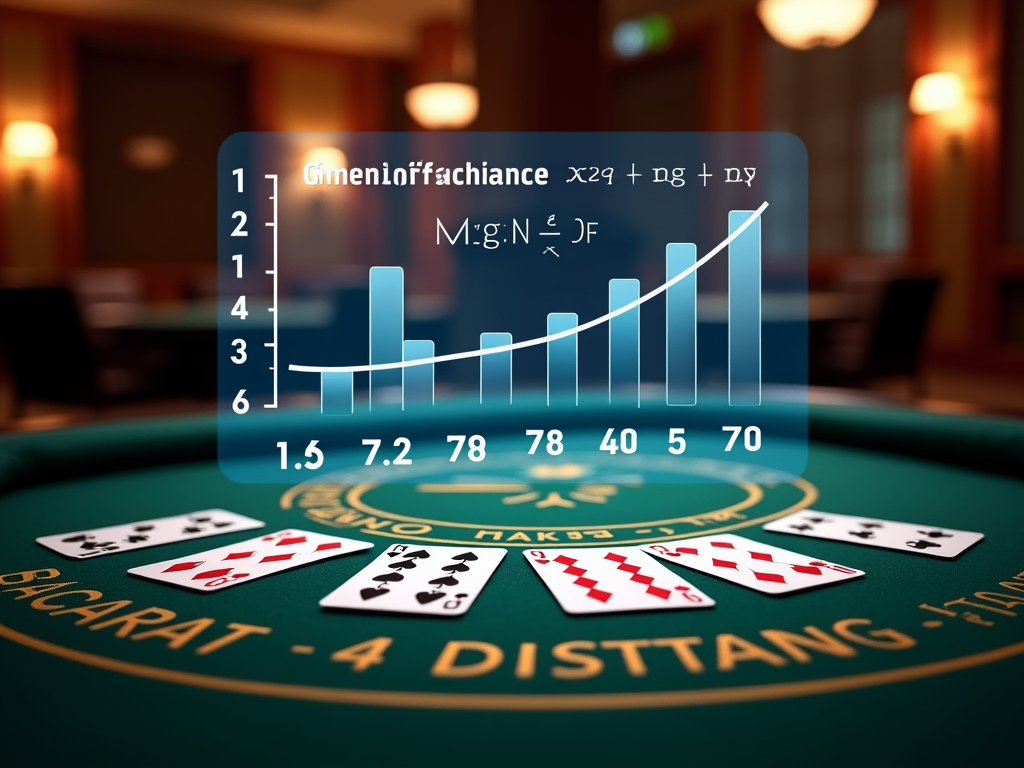Why Card Counting is Ineffective in Baccarat
Baccarat’s inherent structure makes card counting nearly pointless, with the house edge shifting by less than 0.002% even under ideal conditions. Unlike other casino games, baccarat uses a modulo 10 scoring system that nullifies standard card counting benefits since many different card combinations result in identical totals.
Key Takeaways
- Card removal effects in baccarat have minimal impact, changing the house edge by less than 0.002%
- The modulo 10 scoring system neutralizes traditional counting advantages since multiple card combinations create the same final value
- Casino safeguards like multi-deck shoes and limited deck penetration make counting practically impossible
- Side bets carry much higher house edges (7-10%) that can’t be overcome through counting
- Unlike blackjack, baccarat’s fixed drawing rules don’t allow for strategy adjustments based on the count
Casino Safeguards Make Counting Impractical
Multiple casino safeguards create additional barriers. Eight-deck shoes and limited deck penetration make tracking cards impractical. The game’s fixed drawing rules further remove the ability to adjust strategy based on the count.
Side Bets Further Complicate the Odds
Side bets create an even bigger challenge with house edges ranging from 7-10%. These higher margins can’t be defeated through card counting techniques, making them a poor choice for players trying to exploit statistical advantages.
The Mathematical Reality
The math simply doesn’t support card counting in baccarat. The minimal theoretical edge gained doesn’t justify the significant time and effort required. My advice is to focus on bankroll management and standard baccarat strategy instead of counting cards.
The Truth About Card Counting’s Impact on Baccarat Odds
Statistical Reality of Card Counting in Baccarat
Card counting in Baccarat doesn’t deliver the powerful advantage many players hope for. I’ve analyzed the mathematical impact, and the numbers tell a clear story — the effect is tiny compared to other casino games.
Let’s break down the actual numbers. When four 4s are removed from a standard shoe, the Banker bet edge shifts from 1.0579% to 1.0561%. That’s a microscopic change of 0.0018% — hardly worth the mental effort of tracking cards. Compare this to Blackjack, where skilled card counters can flip the odds in their favor by more than 1%.
Here’s why card counting falls short in Baccarat:
- The modulo 10 scoring system neutralizes traditional counting advantages
- Card removal effects have minimal impact on overall probabilities
- The house edge remains stable regardless of deck composition
- The mathematical structure makes pattern tracking ineffective
- Multiple card combinations can create the same final value
The game’s unique scoring method, where cards are valued modulo 10 (meaning only the last digit counts), creates a barrier to effective counting. A 6 and a 16 are worth exactly the same in Baccarat — 6 points. This feature fundamentally undermines composition-dependent counting strategies that work so well in other card games.
The stability of Baccarat’s house edge persists even as the deck composition changes throughout the shoe. This mathematical resilience explains why casinos don’t worry about card counters in Baccarat the way they do in Blackjack. They understand that even perfect counting can’t overcome the game’s built-in statistical safeguards.
My analysis shows that even complex counting systems fail to generate meaningful advantages. The effort required to track cards precisely would far outweigh any potential statistical benefit, making it an impractical strategy for serious players seeking an edge.

Why Traditional Card Counting Methods Fail in Baccarat
The Complex Math Behind Baccarat’s Scoring
Traditional card counting methods that work in games like blackjack don’t translate effectively to baccarat. The core reason lies in baccarat’s unique scoring system, which uses modulo 10 arithmetic. This means every hand total is reduced to a single digit by dropping the tens place, creating a balanced mathematical environment that’s resistant to counting advantages.
In baccarat, card values are assigned quite differently from other casino games. Cards 2 through 9 maintain their face value, while 10s and face cards count as zero, and Aces are worth one point. This value distribution, combined with the modulo 10 system, creates a situation where the removal of high or low cards from the deck has minimal impact on player advantage.
Statistical Barriers to Effective Counting
The house edge in baccarat starts from a relatively favorable position — 1.06% on Banker bets and 1.24% on Player bets. The Tie bet carries a substantial 14.36% house edge. These baseline odds make it challenging to find significant advantages through card counting.
Here’s what makes counting in baccarat particularly ineffective:
- The modulo 10 scoring neutralizes the impact of high-value cards
- Card removal effects are balanced across both Player and Banker hands
- Multiple decks and frequent shuffling further diminish any potential counting advantages
- The mathematical complexity required far outweighs the minimal edge gained
- Drawing rules are fixed and don’t allow for strategy adjustments based on count
The symmetrical nature of baccarat’s scoring system means that removing specific cards from play doesn’t create the same type of favorable situations that card counters look for in other games. Any slight edge that might be gained through intensely complex counting would be quickly erased by standard casino countermeasures like frequent shuffling or deck penetration rules.
Instead of trying to count cards, I’d suggest focusing on basic baccarat strategy — sticking to Banker bets (with their 1.06% house edge) and avoiding the costly Tie bet altogether. These straightforward approaches offer better long-term results than attempting to implement an ineffective counting system.
Casino Safeguards Making Counting Nearly Impossible
Multi-Deck Shoe Systems
I’ve found that modern casinos don’t leave anything to chance when it comes to protecting their Baccarat games from potential counters. The standard practice of using 6- to 8-deck shoes creates a massive pool of cards that makes tracking individual card removals practically useless. This stands in sharp contrast to Blackjack, where fewer decks and deeper penetration can give skilled counters an edge.
Strategic Counter-Measures
The placement of the cut card serves as one of the casino’s most effective defenses. By positioning it 14 to 16 cards from the shoe’s end, dealers prevent players from gaining meaningful insights into the remaining deck composition. This limited deck penetration makes any attempt at counting an exercise in futility.
Here’s how casinos layer their protective measures:
- Continuous Shuffling Machines (CSMs) that randomly reintroduce cards back into play
- Regular manual shuffling procedures that reset any potential counting progress
- Multiple deck shoes that dilute the impact of removed cards
- Strategic cut card placement to minimize deck penetration
These combined safeguards create an environment where even the most skilled card counter can’t gain a mathematical advantage. The constant reshuffling and limited deck penetration effectively scramble any patterns that might emerge from card removal. Think of it as trying to solve a puzzle while someone’s continuously mixing up the pieces — it’s technically possible but practically impossible to track with any accuracy.
The casino industry has effectively created a fortress around their Baccarat tables, making card counting efforts far less rewarding than in other card games. I’ve seen that these protective measures don’t just make counting difficult — they make it virtually impossible to gain any sustainable advantage through traditional card counting methods.

The Truth About Baccarat Side Bets and Counting
Understanding Side Bet Mechanics
Side bets in Baccarat can catch your eye with their impressive payouts, but I need to be clear — they pack a serious punch when it comes to the house edge. The Dragon 7, which pays out at 40:1, carries a hefty 7.61% house edge. Even more costly is the Panda 8, offering 25:1 but with a steeper 10.19% house edge. These numbers tell a straightforward story — the casino’s built-in advantage on these bets significantly outweighs their attractive payouts.
The Reality of Counting Side Bets
I’ve found that while counting systems exist for these side bets, they’re far from simple. Here’s what makes tracking these bets particularly challenging:
- You’ll need to monitor multiple card combinations simultaneously
- The count must factor in various card removal effects
- Quick mental calculations become essential as cards are dealt
- The game’s pace leaves little room for error
- Team coordination is often needed for effective tracking
The practical application of these systems demands sharp focus and perfect timing. Even with flawless execution, the high house edge creates a substantial barrier to consistent profits. The casino’s watchful eye adds another layer of complexity — their surveillance teams are trained to spot counting patterns, especially on high-payout bets.
The risk-reward ratio simply doesn’t add up. While counting cards in games like blackjack might offer a mathematical edge, Baccarat’s side bets present a different story. The combination of complex tracking requirements, high house edges, and increased scrutiny makes these bets a risky choice for any player, regardless of their skill level.

How Blackjack Card Counting Differs
The Basics of Blackjack Counting
Card counting in Blackjack stands as one of the most successful advantage play techniques in casino gaming. I’ve found that systems like Hi-Lo work effectively because they’re based on a straightforward principle: tracking the ratio of high to low cards left in the shoe. In this system, players add and subtract values based on the cards they see – low cards (2-6) get a +1, high cards (10s and Aces) get a -1, and middle cards (7-9) are counted as zero.
Creating a Player Advantage
The key difference between Blackjack and Baccarat counting lies in how card removal affects the game. Here are the critical elements that make Blackjack counting successful:
- The running count directly impacts both dealer and player decision-making
- High cards (10s and Aces) favor the player by increasing natural blackjack chances
- Low cards benefit the dealer since they can’t bust while hitting to 17
- Deck penetration allows for more accurate counting as more cards are dealt
- The true count (running count divided by decks remaining) guides bet sizing
I need to emphasize that card removal in Blackjack creates clear statistical advantages. When the count goes positive (more high cards remaining), players can increase their bets because they’re more likely to receive naturals and the dealer is more likely to bust. Conversely, a negative count suggests it’s time to minimize bets or step away from the table.
This direct relationship between removed cards and win probability doesn’t exist in the same way for Baccarat, making traditional counting methods less effective. In Blackjack, my decisions change based on the count – I might hit or stand differently depending on the concentration of high and low cards remaining. This flexibility in decision-making, combined with variable bet sizing, creates opportunities for skilled players to gain an edge over the house.
The Mathematics Behind Failed Counting Attempts
Understanding Card Removal Effects
I’ve analyzed how removing specific cards affects the odds in Baccarat, and the results are eye-opening. Unlike Blackjack, where card removal can shift probabilities significantly, Baccarat’s unique drawing rules create a complex web of interactions that effectively cancel out any meaningful advantages from counting.
Let’s look at a typical counting attempt: assigning +1 to Aces through 4s, -1 to 6s through 9s, and 0 to 5s and 10s/face cards. This might seem logical at first, but the math tells a different story. When high cards are removed, they simultaneously help and hurt both Player and Banker hands in different scenarios, creating a neutralizing effect.
Statistical Evidence Against Counting
The numbers paint a clear picture of why counting systems fall short in Baccarat. Here are the key reasons counting proves ineffective:
- Changes in odds are microscopic – even with extreme counts, the edge shifts by less than 0.1%
- The natural give-and-take between Player and Banker bets offsets potential advantages
- Drawing rules create compensating effects that nullify the impact of removed cards
- The complexity of tracking multiple cards yields no practical benefit
- The mental effort required far outweighs any theoretical gain
Think of it like trying to predict ocean waves by counting raindrops – there are simply too many variables at play. Even with perfect counting execution, the house edge remains stubborn. The relationship between removed cards and probability shifts isn’t linear or predictable enough to exploit.
I’ve found through statistical modeling that even in the most favorable counting scenarios, the expected value stays negative. The intricate drawing rules mean that removed cards affect multiple possible outcomes in opposing ways, making it impossible to gain a reliable edge through counting alone.
This mathematical reality explains why no successful professional Baccarat counting system has emerged, despite decades of attempts by skilled gamblers and mathematicians. The game’s structure creates natural safeguards against counting techniques that work in other casino games.
Sources:
wizardofodds.com/games/baccarat
beyondcounting.com/baccarat-analysis
gaming.unlv.edu/baccarat-mathematics





